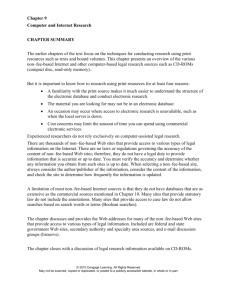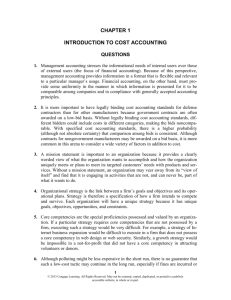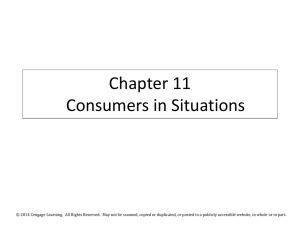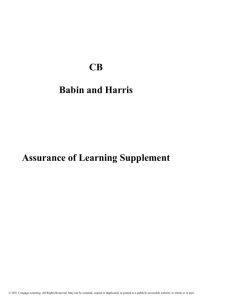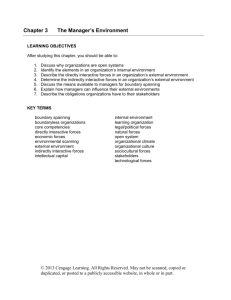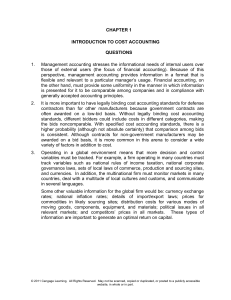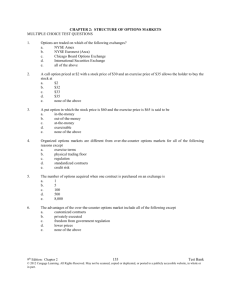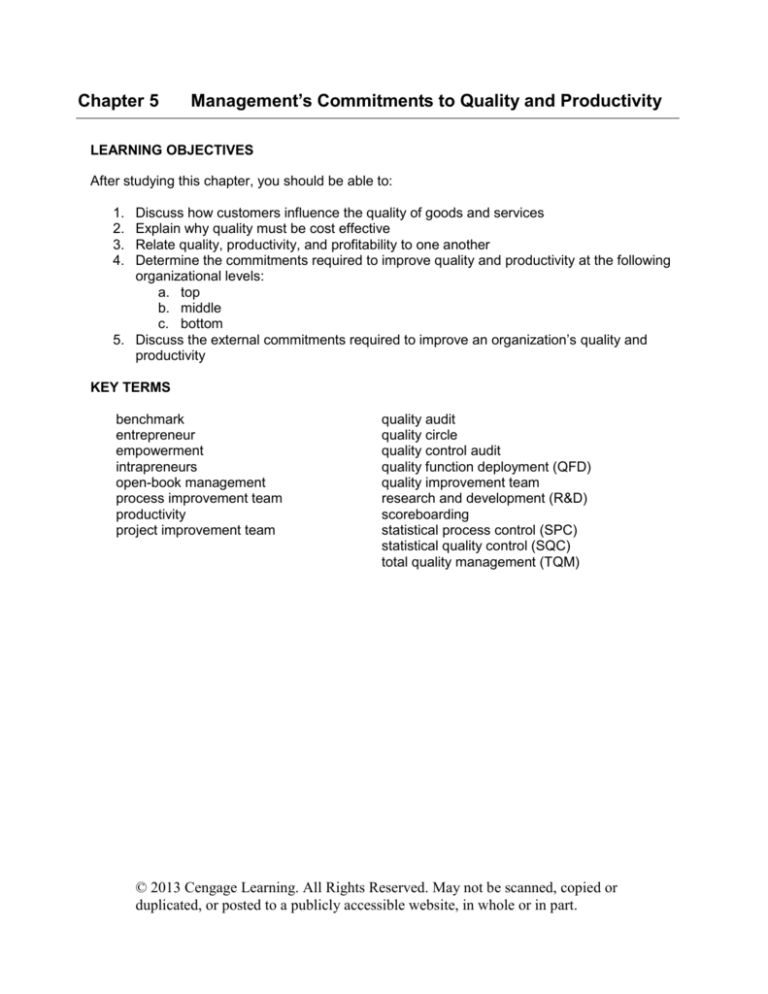
Chapter 5
Management’s Commitments to Quality and Productivity
LEARNING OBJECTIVES
After studying this chapter, you should be able to:
1.
2.
3.
4.
Discuss how customers influence the quality of goods and services
Explain why quality must be cost effective
Relate quality, productivity, and profitability to one another
Determine the commitments required to improve quality and productivity at the following
organizational levels:
a. top
b. middle
c. bottom
5. Discuss the external commitments required to improve an organization’s quality and
productivity
KEY TERMS
benchmark
entrepreneur
empowerment
intrapreneurs
open-book management
process improvement team
productivity
project improvement team
quality audit
quality circle
quality control audit
quality function deployment (QFD)
quality improvement team
research and development (R&D)
scoreboarding
statistical process control (SPC)
statistical quality control (SQC)
total quality management (TQM)
© 2013 Cengage Learning. All Rights Reserved. May not be scanned, copied or
duplicated, or posted to a publicly accessible website, in whole or in part.
CHAPTER OUTLINE
I. INTRODUCTION
II. QUALITY, PRODUCTIVITY, AND PROFITABILITY
A. Quality Function Deployment
1. Total Quality Management
2. TQM Principles
III. COST EFFECTIVE QUALITY
A. Productivity
IV. QUALITY PRODUCTIVITY-PROFITABILITY LINK
A. Improving Quality and Productivity
B. Business Process Reengineering (BPR) Approaches
V. COMMITMENTS AT THE TOP
A. Open-Book Management
B. Empowerment
VI. COMMITMENTS AT THE MIDDLE
A. Teams
B. Audits
C. Measurements
VII. COMMITMENTS AT THE BOTTOM
VIII. EXTERNAL COMMITMENTS
A. Additional Internal and External Influences on Quality and Productivity
B. Internal Influences
C. External Influences
Enrichment Vignette
At one time, AT&T was the world’s largest corporation, and its products and services set a
standard of quality for the entire world. The corporation owned a manufacturing organization
known as Western Electric. (Western Electric was ultimately spun off as an independent
company and renamed Lucent Technologies.) Western Electric produced the equipment
needed by the telephone companies. AT&T owned the telephone companies that bought the
equipment from Western Electric. Western Electric engineered and produced high-quality
products and charged the telephone companies a price that covered those costs. The telephone
companies did not have to worry about the prices paid to Western Electric because at that time
AT&T’s telephone companies had a monopoly on telephone service and regulatory
organizations normally allowed the telephone companies to pass the cost on to the consumers.
However, in the 1980s, AT&T was split up as a result of government antitrust action, and the
telephone companies then became independent of AT&T. Also, competition in the long-distance
market and in other telephone services motivated the telephone companies to look for less
expensive equipment than was available from the manufacturing operations that remained part
of AT&T. Quality was still important to the telephone companies, but rapidly changing
technology meant that a product might become obsolete in three years. Therefore, customers
would not be willing to pay for a product of such high quality (and cost) that it will last thirty
years. AT&T now had the challenge of not only producing quality products but of producing the
right level of quality so that the products could be sold at a price the customers were willing to
pay.
© 2013 Cengage Learning. All Rights Reserved. May not be scanned, copied or
duplicated, or posted to a publicly accessible website, in whole or in part.
LECTURE OUTLINE
The outline below (the lecture outline) is referenced to the above chapter outline and contains
supplementary material to enhance your discussion of the chapter, but it is organized somewhat
differently. As a result, you have a choice: by using what is in the outline below, (1) you may
present the above chapter outline material in a different sequence, or (2) you may use the
chapter outline references in the outline below to present the lecture outline material in the
same sequence as the chapter outline.
I.
INTRODUCTION (CHAPTER OUTLINE: SECTION I)
II.
QUALITY, PRODUCTIVITY, AND PROFITABILITY
(CHAPTER OUTLINE: SECTIONS II and III)
A.
Productivity and Quality Defined
1.
2.
3.
In spite of quality, overpriced products can cause customer dissatisfaction.
Quality has many distinct definitions.
Productivity is the relationship between the amount of input needed to produce a
given amount of output.
4. Joseph M. Juran relates quality to product performance and freedom from
deficiencies.
The ultimate goal of quality is perfection for customer needs.
B.
Quality Function Deployment (QFD)
1. Total Quality Management
2. TQM Principles
3. Developed by Professor Yoji Akao of Japan, QFD is a disciplined approach to
solving quality problems before the design phase of a product.
4. QFD links customer expectations to the technical considerations of the designer
and manufacturer, transforming customer wants and needs into quantitative
terms.
5. The best product becomes the benchmark in the manufacturing process, or the
product to meet or beat in terms of design, manufacture, performance, and
service.
C.
Cost-Effective Quality
1. Scholars and industry experts have different views on the link between quality,
productivity, and profitability.
a.
b.
c.
d.
W. Edwards Deming sees quality only in terms of supplier, producer, user, or
customer and the interrelationships of these components.
Philip B. Crosby views quality as conformance to requirements.
The American Society for Quality Control is recognized as a distinguished
membership association relating to dimensions of quality within this country.
Do it right the first time (DIRFT) is self-explanatory.
© 2013 Cengage Learning. All Rights Reserved. May not be scanned, copied or
duplicated, or posted to a publicly accessible website, in whole or in part.
e.
Quality does not merely happen without accompanying costs.
D.
Productivity
E.
Quality-Productivity-Profitability Link (CHAPTER OUTLINE: SECTION IV)
1.
Creation of TQM
a.
b.
c.
2.
Components of TQM
a.
b.
c.
d.
e.
3.
Robert Costello, engineer and former GM executive, is credited with creating
total quality management (TQM).
The Department of Defense developed a seven-step model to illustrate
TQM.
TQM is also referred to as total quality control (TQC).
Quality control (QC) and quality function deployment (QFD) are basic
components of TQM.
QC is a system of production methods that economically produces quality
goods and services to meet customer requirements.
Statistical quality control (SQC) uses statistical methods and tools to ensure
quality.
QFD attempts to build quality into the design of products.
The reference term to the best competing product is “benchmark.”
Major Contributors to TQM
a.
b.
c.
d.
e.
G. S. Radford advocates inspection as a cornerstone to industrial quality
control.
Walter A. Shewhart, at Bell Laboratories, created statistical quality control
(SQC) and statistical process control (SPC).
W. Edwards Deming, the guru of TQM, is known for:
1. Helping and assisting the Japanese to rebuild their industrial economy
from the 1940s to the present.
2. Publishing a list of the seven “deadly diseases” or common barriers to
quality control to be addressed later in this chapter.
3. Publishing a checklist of 14 points to improve quality.
Joseph M. Juran’s TQM contributions include a trilogy of quality
management to achieve quality planning, quality control, and quality
improvements. The trilogy is as follows:
1. Quality planning. This aspect of management involves budgeting and
business planning.
2. Quality control. In this part, managers control costs, expenses, and
inventory.
3. Quality improvements.
This aspect of management involves cost
reduction and profit improvement.
Armand V. Feigenbaum believes that quality control is a system or total
process of activities and that quality specialists should have the authority for
quality efforts. To many, this view is outdated and not accepted.
© 2013 Cengage Learning. All Rights Reserved. May not be scanned, copied or
duplicated, or posted to a publicly accessible website, in whole or in part.
f.
g.
F.
Irony of America’s Approach to Quality
1.
2.
3.
III.
Philip B. Crosby contends that everyone should be trained by quality experts
in areas of quality to include control, assurance, and management. Crosby
also devised a five-stage quality management maturity grid.
Thomas J. Peters, author, lecturer, consultant, and professor has
investigated successful companies that are doing the right things. Peters
views quality as always improving, watching and imitating your best
competitors, and staying ahead of trends.
Americans preach more about quality than they practice.
Action and implementation must follow strategy and design.
The quality of competitive Japanese and German products is primarily attributed
to the “awakening” for improving quality standards in this country. We have
awoke...Now we need to get busy!
IMPROVING QUALITY AND PRODUCTIVITY
A.
Business Process Reengineering (BPR) Approaches
B.
Commitments at the Top
1. Mission
2. Vision
3. Core Values
4. Open-Book Management
5. Empowerment
C.
COMMITMENTS AT THE MIDDLE
1. Teams
2. Audits
3. Measurements
D.
Commitments at the Bottom
E.
External Commitments
1.
Includes customers and partners such as vendors and suppliers. When outsourcing,
firms must work with those handling outsourced activities.
© 2013 Cengage Learning. All Rights Reserved. May not be scanned, copied or
duplicated, or posted to a publicly accessible website, in whole or in part.
IV.
ADDITIONAL INTERNAL AND EXTERNAL INFLUENCES ON QUALITY AND
PRODUCTIVITY (CHAPTER OUTLINE: SECTION IIX)
A.
Internal Influences
1.
B.
Includes information, facilities, machinery and equipment, materials and supplies,
and financing.
External Influences
1.
Includes economic, legal/political, sociocultural, natural, and technological
conditions in foreign and domestic markets.
Enrichment Vignette
The Baldrige Award is industry’s Oscar. It doesn’t look like much—just gold-plated metal
embedded in a piece of crystal a little over a foot high. Yet nothing seems to have stirred the
lusts of American executives like the Malcolm Baldrige National Quality Award. In essence, the
award is to U.S. industry what the Oscar is to Hollywood: a testimonial that the recipient is
simply the very best there is.
Created by Congress in 1987, the Baldrige is intended to highlight quality as a key
ingredient of world competitiveness and to serve as a practical guide zero-defect strategy.
Applicants first must complete a painstaking self-analysis via guidelines furnished by the
Baldrige committee. The entries are then scrutinized by a panel of independent examiners.
The relatively few companies or operating units that survive the first cut are then subject to an
on-site review of operations.
SUGGESTED RESPONSES TO REVIEW QUESTIONS
What influence over the quality of a product or service do customers really have?
1.
Customers/consumers of the new millennium set the tone for the quality of goods and
services that they shop for, purchase, and consume. With the highly competitive
nature of the current business world, customers can dictate who, what, when, where,
why, and how much regarding market commodities and services.
2.
How can a company make the quality of its goods and services cost-effective?
In conjunction with the response to question 1, the amount of expenditures spent
during the process of providing quality will affect the final or overall cost of the
products and/or services involved.
Efficiency of costs will be an important
consideration in all stages of the market system from manufacturing to consumption.
3.
Why must efforts to improve quality lead to improvements in both productivity and
profits?
Quality affects productivity. Quality and productivity affect profitability. The drive for
any one of the three must not interfere with the drive for the others. Efforts at
© 2013 Cengage Learning. All Rights Reserved. May not be scanned, copied or
duplicated, or posted to a publicly accessible website, in whole or in part.
improvement need to be coordinated and integrated. The real cost of quality is the
cost of avoiding nonconformance and failure. Another cost is the cost of not having
quality—of losing customers and wasting resources.
4.
What must top management commit to if it wants its organization to improve its
productivity and quality and, therefore, its profits?
Companies can improve productivity by securing the commitment of top-level
managers, implementing sound management practices, using R&D effectively,
adopting modern manufacturing techniques, and improving time management.
5.
How do middle managers contribute to their organizations’ efforts to improve both
quality and productivity?
Middle managers are most active in planning and coordinating quality and productivity
efforts. They must make certain that any breakthroughs are shared with others to
enable any benefits to be shared throughout the organization. Because most
processes are horizontal, cross-functional cooperation and communication must take
place.
6.
In what ways do workers affect productivity and quality? In what ways do they affect
the efforts to improve both?
Student responses will vary. Some common responses that illustrate how employees
improve productivity include their ability to accept and adapt to change, commitment to
TQM, working smarter not harder, self-education, and continually improving all facets of
their work.
7.
What external commitments affect quality and productivity improvement efforts?
Various groups outside an organization have direct and indirect bearing on both its
quality and productivity. Companies must continually interact with their customers
and various partners. By far the greatest influence is exerted by customers. Whether
an organization has as its customers individual consumers or industrial users, it must
develop leaning relationships—continuing connections to meet their needs and gain
their loyalty.
INSTRUCTIONAL EXPLANATION: DISCUSSION QUESTIONS FOR CRITICAL THINKING
These thought-provoking questions are provided by the authors for each chapter as
primers for student discussion. This method of questioning ensures that the students have read
the assigned materials or content. These questions are presented to generate thinking and
discussion. They can be used as supplemental homework assignments and/or class
discussions that center on specific critical thinking issues and applications.
It is important that students are able to respond from their experiences and through their
perceptions as well as incorporate the specific course content into their reasoning, explanations,
descriptions, and individualized contributions. Most of these questions cannot be answered in a
right/wrong fashion.
Instead, student responses and/or group discussions should be
encouraged by the instructor to bring out individualized critical thinking as opposed to absolute
© 2013 Cengage Learning. All Rights Reserved. May not be scanned, copied or
duplicated, or posted to a publicly accessible website, in whole or in part.
correct answers.
WEB 2.0 EXERCISES
The Matrix of Web 2.0
What is it? It’s an experimental interactive grid with Web 2.0 API’s along each axis and the
intersecting cells correspond to the mashups made by combining each pair of APIs. As you
move the cursor across the grid a box dynamically displays details about each intersection. You
can go directly from the matrix to view the examples or drill-down into this site’s API database.
The page is updated daily. You can get more details at the matrix’s About page."
Choose a company. Visit its website. Develop “The Matrix of Web 2.0” for the company.
The student answers to these questions will vary greatly. Similar to the critical thinking
questions provided throughout the text, these questions allow students the opportunity to think
in a broad, creative sense with many variables or choices for response. It is important that the
instructor encourage the students to “back up” or support their answers with specific subject
content from the text as well as provide a rational/logical approach to their comments.
SUGGESTED RESPONSES TO EXPERIENTIAL LEARNING CASE: AFGHISTAN
CONSUMERS PREFER QUALITY AUTOMOBILES
1.
What problems face Russian automotive manufacturers?
Although students may list a variety of problems, those problems involve the need of
Russian automotive manufacturers to transition into a globally competitive environment.
(Their previous environment was one in which the government makes all the decisions and
consumers must accept whatever is available.) Since Russian consumers can find better
quality and a more affordable price in Japanese used cars than in Russian cars, they will
buy those cars instead. The Russian carmakers must therefore either provide the quality
and price desired by consumers regarding cars or find some other type of product that can
be produced as desired by the buyers.
2.
How is each problem you identified in Question 1 related to the quality of Russian-made
autos?
The answer to this question will depend on their answer for question one but all should be
able to identify the connection to quality.
3.
How can Russian automobile manufacturers become customer driven?
Student answers will vary but to the extent that the manufacturers need to operate
profitably and do not have any protection such as tariffs, they will be forced to either satisfy
the customer or go out of business.
ADDITIONAL CASE PROBLEMS WITH SUGGESTED ANSWERS
Tenneco’s Case Corporation Adopts a Customer Focus
© 2013 Cengage Learning. All Rights Reserved. May not be scanned, copied or
duplicated, or posted to a publicly accessible website, in whole or in part.
Wisconsin-based Case Corporation was a wholly owned division within Houston-based
Tenneco, Inc., until 1995. Its specialty is the manufacture of farm and construction equipment.
From the early 1980s through the early 1990s, “Case made a virtual art of ignoring the market.”
and found itself with excess manufacturing capacity, products it could not sell, bloated operating
costs, and losses of well over $1 billion. During those years its management had made many
efforts to fix the things that were wrong, but interference and micromanaging from its parent’s
(Tenneco’s) managers resulted in limited progress.
The problems these managers wrestled with were many. One primary problem was the
inward focus of Case’s managers. Instead of looking outward and focusing on customers,
managers seemed trapped in the past, holding the nineteenth and early twentieth century view
that “if we make it, people will buy it.” The company had enormous manufacturing capacity. To
utilize these facilities to their fullest, Case continued to make products that were not competitive,
thus overburdening its company-owned dealerships. For example, its line of tractors was
underpowered in relation to its competitors’ models and lacked their automobile-like finishes. To
move these tractors and other noncompetitive products to users, dealers had to continually cut
their retail prices, thus cutting the company’s profit margins in the process.
Another problem was one of inefficiency. Case manufactured many of its products’
component parts in-house at a cost far higher than outsiders would have charged to make them.
This practice carried with it the added burdens of too many people on the payroll and their
related overhead costs.
In 1991 Tenneco’s board of directors hired a turnaround specialist, Michael H. Walsh, as
Tenneco’s CEO. He hired an International Paper Company executive, Dana G. Mead, to take
over the top-management job at Case. Mead inherited company dealerships “with eleven
months of inventory—four months above the industry average—and no customers.” Armed with
an infusion by Tenneco of much-needed cash and a commitment to avoid the mistakes of the
past, Mead assembled a new leadership team. The team created a turnaround plan and was
given the power to act on it. Managers’ bonuses were linked to achieving the plan’s targets, and
additional motivation was provided through a promise that, if the company became profitable, it
would be sold off and managed as an independent enterprise.
The first of many reforms dealt with the reduction of costs. Excess inventory was sold.
Heavy debt incurred in the past was refinanced at lower rates of interest. Unprofitable products
were dropped. Some plants were closed immediately and plans were laid to close others by
1997. As payrolls were cut, the manufacture of many components was and continues to be
shifted to outside suppliers. Most of Case’s 250 dealerships were sold. But Case’s management
“knows that cost cutting alone won’t sell more tractors.”
The company’s managers are building on reforms begun in 1992. Beginning in that year
the company decided that it would be customer driven. It started by seeking customer feedback
on its new design for a loader backhoe—a vehicle with entrenching and front-end loading
capabilities. While the first test model was being built, “Case sent teams of engineers and
marketing managers to talk to 150 key customers and users of rival machines. They quickly got
an earful.” The company invited valued customers to test its prototype vehicle. Over several
days they compared its performance against that of its competitors’ machines. Like many who
tested the vehicle, Larry Willingham liked some features but not others. One dominant feature
was its weight of about 16,000 pounds. It was too heavy for him to use because he would have
to buy a new truck to transport it. When he returned a year later to see the proposed final
production model of the loader backhoe, Willingham was pleased. Among other things, it
weighed only 12,900 pounds. Said Willingham, “I definitely felt they listened to me.”
© 2013 Cengage Learning. All Rights Reserved. May not be scanned, copied or
duplicated, or posted to a publicly accessible website, in whole or in part.
After getting the green light from its customers, Case totally overhauled the Burlington,
Iowa, factory that now produces the new vehicle. Ten million dollars was invested just to
improve the rust protection and painting operations. When the new model was introduced in
1995, it was an instant success with customers. Production could not keep up with demand.
Case is expanding the involvement of its customers in its product design. Profits and sales have
steadily increased since 1991, and overhead expenses have fallen. Case’s gross profit for 1994
was 23 percent, higher than any of its competitors’. Tenneco delivered on its promise to sell the
company to investors. In 1995 Case became Case IH, consolidating International Harvester with
Case. Tenneco’s decreased ownership in Case resulted in Case becoming 79% publicly owned.
Sources: Kevin Kelly, “Case Digs Out from Way Under,” Business Week (14 August 1995),
pp.62–63; Case Corporation Company History,
http://www.caseih.com/corporate/history/index.html; Case Corporation, http://www.caseih.com.
QUESTIONS
1.
2.
What problems was Case facing before its turnaround team took over?
The traditional approach by management was the primary problem. Various other student
comments and problem identities will arise regarding this question.
How is each problem you identified in question 1 related to the quality of Case’s products
and processes?
There will be numerous replies and interpretations from students regarding this question.
3.
What did Case’s turnaround team do to deal with each problem you have identified?
Student responses will vary from cost changes to personnel changes. Ensure that each
problem is identified and explained, and that the solutions are individually matched to
specific problems discussed. Students must also recognize problem sources and problem
symptoms and identify the differences.
4.
How did Case become customer driven?
In short, Case changed to a customer-driven operation as cited with several examples.
Encourage students to cite more than one example.
Worker Involvement and Output
Several recent studies done in Japan, Italy, and Sweden draw close connections between
worker involvement in decision-making on the manufacturing plant floor and the amount and
quality of these workers’ output. Automation has extensively replaced human labor in these
countries, with machines performing the most routine, repetitive, and hazardous assembly
operations. Quality circles in Japan and in Scandinavian countries seem to be more effective
than they are in America.
QUESTIONS
1.
Is there a danger in trying to apply in America what works in some other countries?
© 2013 Cengage Learning. All Rights Reserved. May not be scanned, copied or
duplicated, or posted to a publicly accessible website, in whole or in part.
Yes. Ask students how social, economical, political, cultural, and philosophical differences
vary between countries.
2.
If your answer to question 1 is yes, what are the dangers or problems you can foresee?
The countries mentioned in the case are very homogeneous with regard to their customs,
traditions, laws, and population mixes. America has such a diversity of cultural and ethnic
blends that what works for a Japanese group is not likely to work for a mixed group of
typical American workers. Experiments in one factory or country can only suggest possible
applications and become the base for further experiments. Quality circles have had a
longer time to work for the nations mentioned in the case. Management has less trouble
and conflict with its unions in Scandinavia and Japan. There is more of a partnership
between labor and management in these areas than in America. Our experiments are
much younger and will take time to yield the kind of benefits other nations have already
experienced. American manufacturers are moving into robotics while other foreign
manufacturers have had them for several years. Much remains to be done in terms of
hiring people who are suited for the work they will be doing and to get people retrained and
capable of handling the new skills demanded by a more highly technical workplace.
Marsha Stout
Marsha Stout is rereading the president’s memo on improving productivity. It states that funds
are now available for the acquisition of “necessary capital equipment that, in the manager’s
eyes, will contribute significantly to improved productivity.” Marsha oversees six people who
form an administrative assistant team. Her people do all the word processing for the central
office management group, which consists of eight people including the president. Since her
team was formed three years ago, Marsha has pleaded with the office manager to provide funds
in order to replace the six computers her people now use. All of the computers are at least five
years old and all have needed repairs fairly regularly over the past year. Marsha believes that
replacing the six machines with the most modern computers available will improve her group’s
output and morale.
In line with the guidelines set forth in the president’s memo, Marsha has prepared her
request for six new computers. Each will cost $950. In her request, Marsha included the
following reasons why, in her judgment, the new computers are going to improve her group’s
productivity:
Repair costs for existing computers have averaged $1,210.50 for each of the last
three years, but have risen to $1,367.15 this year.
Machines undergoing repairs are out of warranty and unavailable for use while they
are being serviced.
Frequent employee complaints about the poor and old equipment have lowered her
subordinates’ morale.
The new computers will standardize capabilities, allowing for the easy rotation of jobs
to any available operator and machine.
© 2013 Cengage Learning. All Rights Reserved. May not be scanned, copied or
duplicated, or posted to a publicly accessible website, in whole or in part.
QUESTIONS
1.
Has Marsha justified her request for funding the new computers in line with the president’s
memo?
Marsha has not justified her request. The memo states that funds may be spent on capital
equipment that “...will contribute significantly to improve productivity.” She has included
numbers and the fact that machines under repair are unavailable for use. No mention of
time lost for production in specifics appears, and no mention of her employees’ morale
problems with the tired equipment has been stated. She is making an assumption that the
new computers will boost productivity, but she has made no mention of facts to justify that
assumption.
2.
As the office manager, what additional facts might you wish to have before approving
Marsha’s request?
Answers to the following questions will prove useful:
How much time is lost to production while computers are being repaired?
What makes Marsha think that new computers will boost productivity?
How were the computers requested chosen? Were two or more models and vendors
considered, and are the features adequate for our needs?
Have repair costs been linked to specific computers so that the most expensive to
repair can be identified? What are the primary breakdowns linked to? Are all the
existing machines under repair or only a few?
Is standardization of capabilities needed or desirable? Why?
Might it be better to identify the computers that are currently quite useful and replace,
over a schedule of two or more years, the others?
Until these questions are answered to the office manager’s satisfaction, Marsha has not
justified her request.
ON THE JOB VIDEO CASE SOLUTIONS: Numi Teas: Value Chain, IT
Discussion Questions and Suggested Answers:
1.
Many people consider how long a product will last as one measurement of quality
and that measurement may be relevant to tea and other food products. However, does
that always apply to other types of products? Producing a product with a long life may
add to costs and a higher price. For many non-food products, technology and market
changes may render a product obsolete long before its product life expiries, and thus the
higher cost to ensure long life may be pointless. Furthermore, the resulting higher price
may negatively affect overall sales volumes and profits. If you were in charge of a firm’s
quality, how would you deal with the issue of product life versus price in view of potential
© 2013 Cengage Learning. All Rights Reserved. May not be scanned, copied or
duplicated, or posted to a publicly accessible website, in whole or in part.
obsolescence?
2.
Your competitor is gaining market share at your expense because that firm cuts
corners on quality to keep price down. It can do so because there are certain
components within the product that customers do not see and which usually are
faultless. If they do go wrong the customer would not be sure whether the problem was
due to the product or the person using it. If you were the CEO, how would you respond
to that competitor?
3.
Explain how one may spend more to produce a higher quality product and yet be
able to (1) lower prices through greater productivity and sales volume, and (2) increase
profits. Note: It can be done!
The student answers to these questions will vary greatly. Similar to the critical thinking
questions provided throughout the text, these questions allow students the opportunity to think
in a broad, creative sense with many variables or choices for response. It is important that the
instructor encourage the students to “back up” or support their answers with specific subject
content from the text as well as provide a rational/logical approach to their comments.
TEAM ACTIVITY
Corporations are not the only ones who must provide the desired quality in order to survive.
Students must also provide the desired quality in their assignments such as term papers.
Assign a team of students to apply the quality control concepts in this chapter to the problem of
developing a system or approach that will help students to achieve the level of quality in term
papers that would be desired by most instructors.
BIZ FLIX VIDEO CASE
Video Case: In Bruges
Video Case Synopsis
Hit man Ray (Colin Farrell) botches the simple job of murdering a priest in a confessional. The
“botch” occurs when a bullet passes through the priest’s body into a young boy’s head. Deeply
troubled, Ray and fellow hit man Ken (Brendan Gleeson) go to the beautiful medieval Flemish
city of Bruges, Belgium. Ken engages in tourist activities, which Ray finds highly boring. Various
characters, such as an American dwarf actor and a beautiful woman selling drugs on a film set,
add color and interest to this film.
In this trouble, a ticket seller is very rude to Ken. Later, Ken returns to the same ticket
booth with his colleague Harry (Ralph Fiennes), and again the ticket seller is rude. Harry beats
the ticket seller.
Video Case Discussion Questions and Suggested Answers
Ken is the customer, and the ticket seller responds to him as a customer. Do you perceive the
ticket seller as being concerned with the quality of his customer service? Why or why not?
© 2013 Cengage Learning. All Rights Reserved. May not be scanned, copied or
duplicated, or posted to a publicly accessible website, in whole or in part.
The ticket seller does not show any concern for service. Ken wants to use his coins and he falls
short by 10 cents. The ticket seller reacts with no compassion or acceptance, emphasizing it by
tapping on the sign showing the entry fee. He does that twice while saying, “Entry is 5 euro.”
One can only speculate about the results of an assessment of customer satisfaction for entering
the tower.
Do you predict that the ticket seller’s customer approach will result in negative results for him?
Why or why not?
The ticket seller does not know Harry Waters is a gangster and killer. He approaches Harry in
the same way he interacted with Ken. He clearly has no concern or sensitivity regarding his
customers, and doesn’t seem to care who he offends. Some students may mention, however,
that Harry’s offer to pay 100 euros to see the tower should have been a clue that Harry is an
unusual customer, which could lead to an unusual outcome.
The ticket seller most likely holds a position at the bottom of his organization. What are some of
the probable reasons he does not share a commitment to quality customer service?
Students will probably answer that upper and middle management have never empowered or
encouraged him to provide friendly service or to make accommodations for customers in special
circumstances, for example, when the customer is 10 cents short. Some students may also
speculate that he works at a unique tourist attraction, and therefore does not feel the need to
compete for customers.
© 2013 Cengage Learning. All Rights Reserved. May not be scanned, copied or
duplicated, or posted to a publicly accessible website, in whole or in part.



